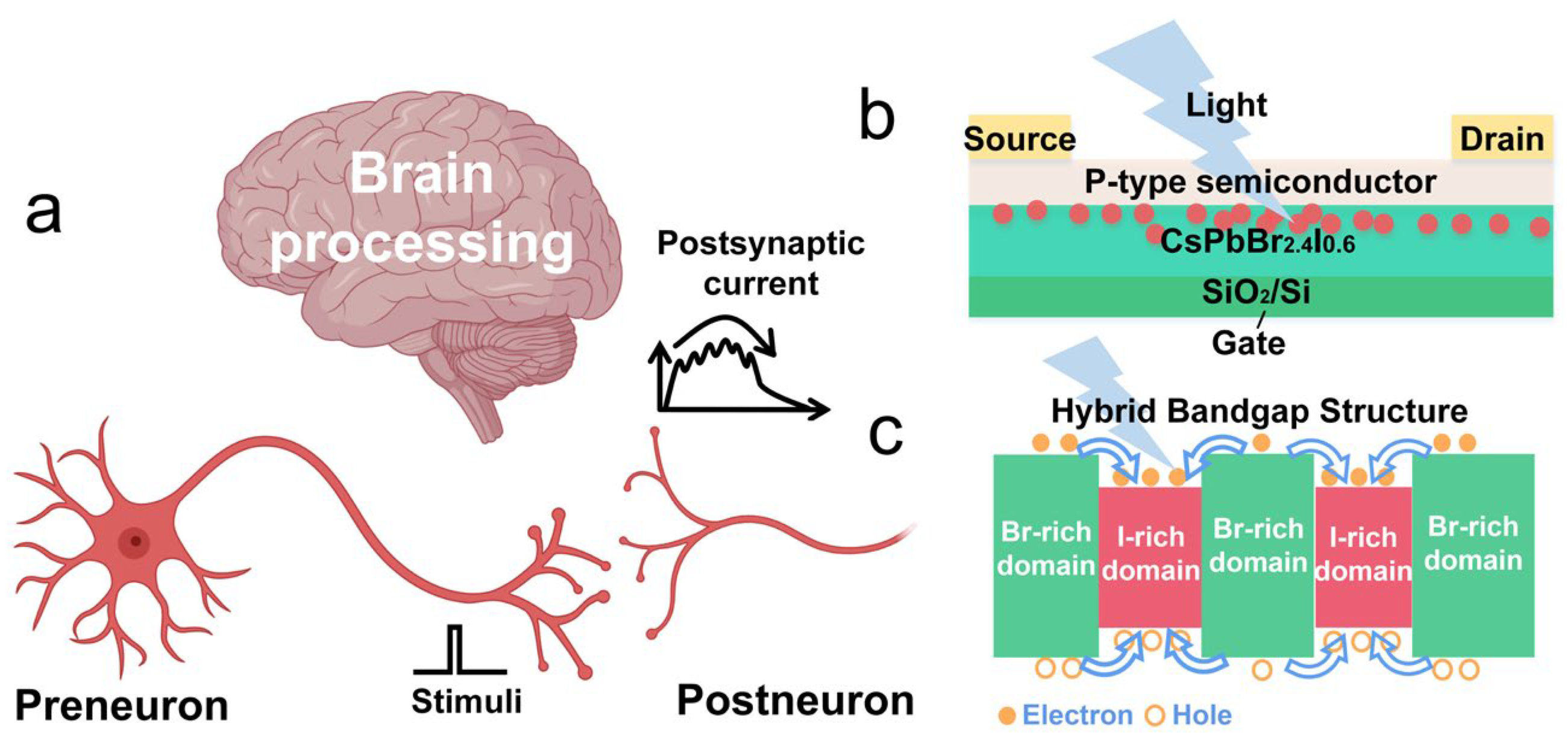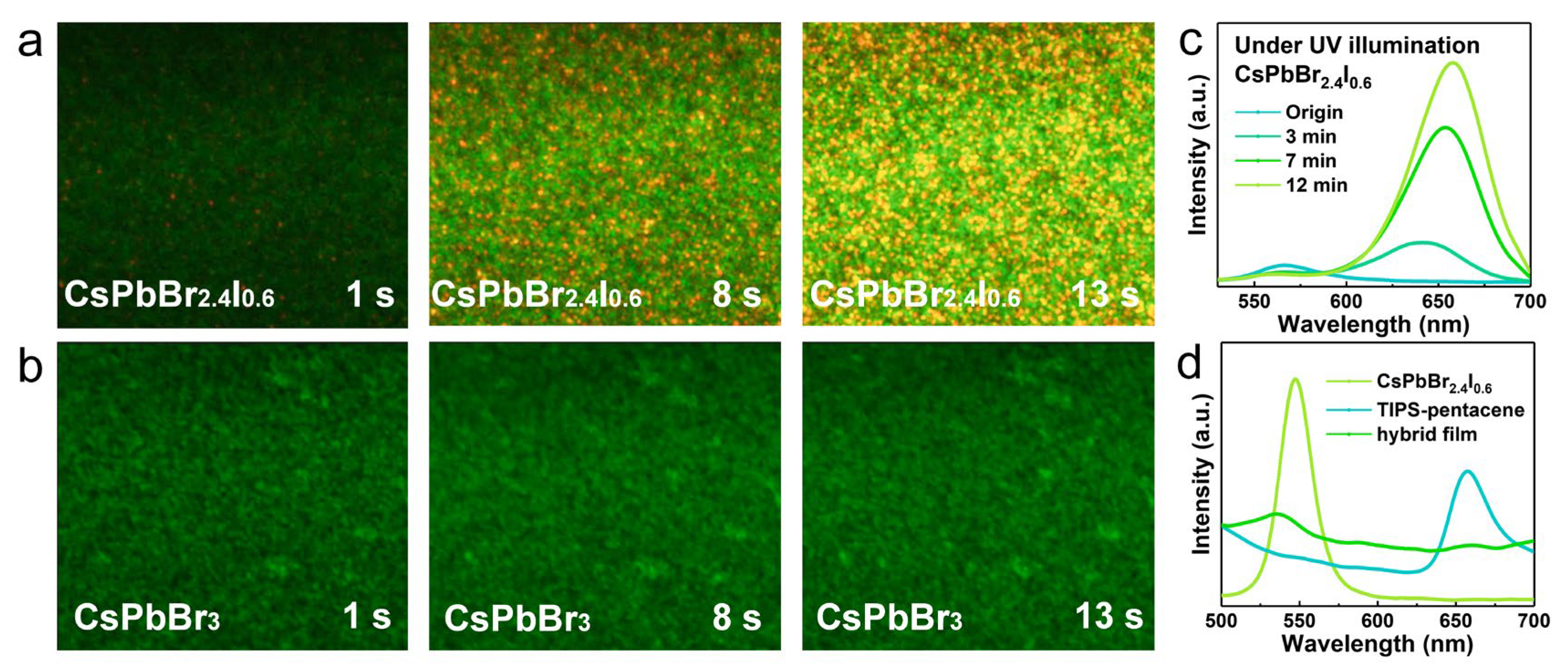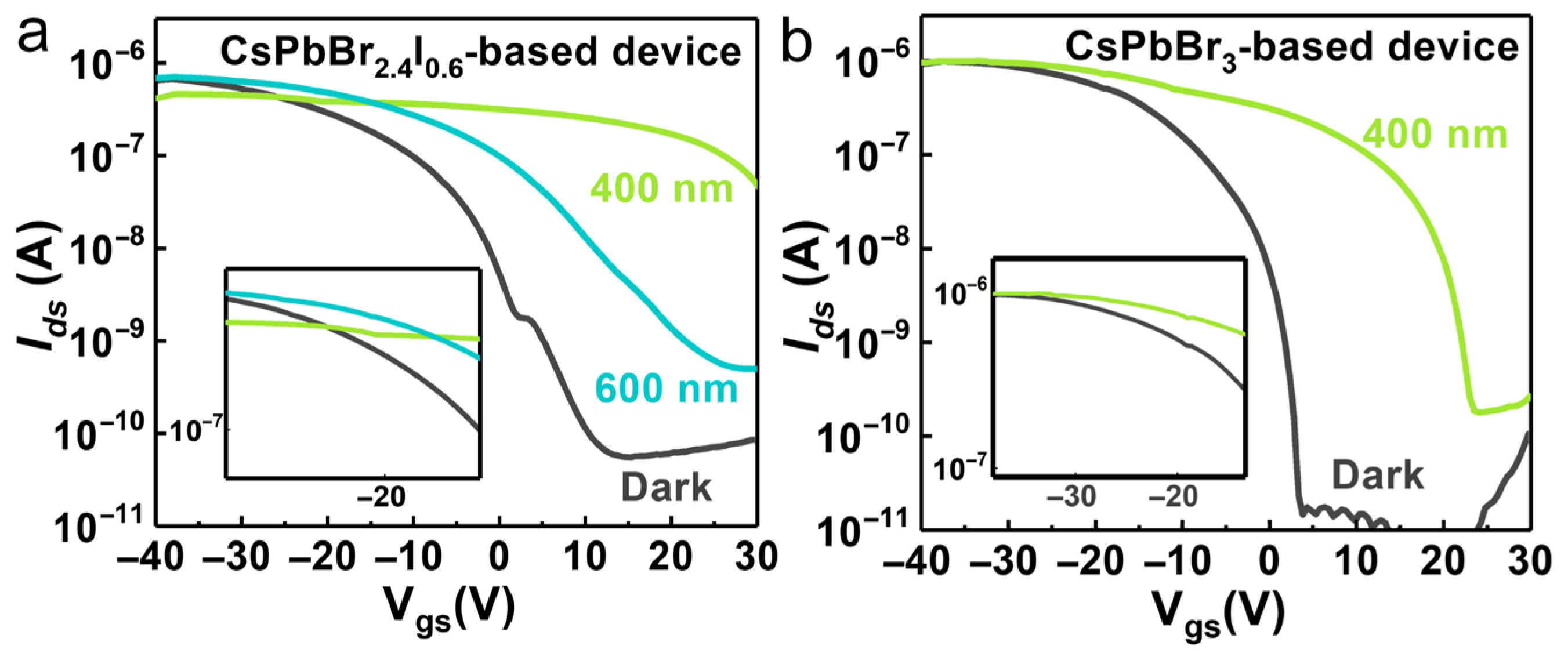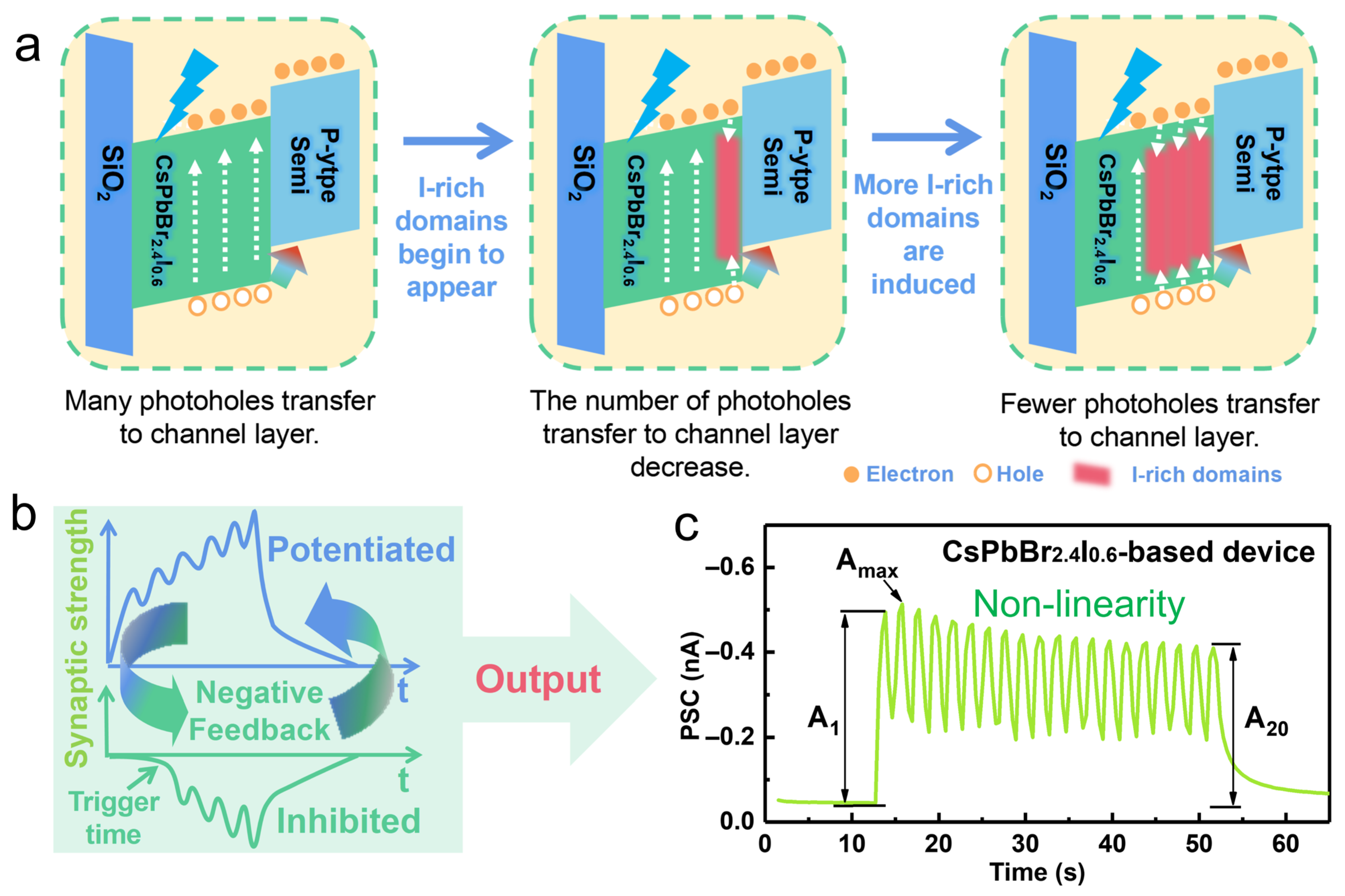A Perovskite-Based Photoelectric Synaptic Transistor with Dynamic Nonlinear Response
Abstract
1. Introduction
2. Materials and Methods
2.1. Hybrid Transistor Fabrications
2.2. Characterizations
3. Results and Discussion
4. Conclusions
Supplementary Materials
Author Contributions
Funding
Institutional Review Board Statement
Informed Consent Statement
Data Availability Statement
Conflicts of Interest
References
- Wang, Y.; Liu, S.; Zhang, H.; Cao, Y.; Mu, Z.; Yi, M.; Xie, L.; Ling, H. Adaptive optoelectronic transistor for intelligent vision system. J. Semicond. 2025, 46, 021404. [Google Scholar] [CrossRef]
- Chen, H.; Cai, Y.; Han, Y.; Huang, H. Towards Artificial Visual Sensory System: Organic Optoelectronic Synaptic Materials and Devices. Angew. Chem. Int. Ed. 2024, 63, e202313634. [Google Scholar] [CrossRef] [PubMed]
- Tang, J.; Yuan, F.; Shen, X.; Wang, Z.; Rao, M.; He, Y.; Sun, Y.; Li, X.; Zhang, W.; Li, Y.; et al. Bridging Biological and Artificial Neural Networks with Emerging Neuromorphic Devices: Fundamentals, Progress, and Challenges. Adv. Mater. 2019, 31, 1902761. [Google Scholar] [CrossRef] [PubMed]
- Chen, H.; Li, H.; Ma, T.; Han, S.; Zhao, Q. Biological function simulation in neuromorphic devices: From synapse and neuron to behavior. Sci. Technol. Adv. Mater. 2023, 24, 2183712. [Google Scholar] [CrossRef] [PubMed]
- Liao, F.; Zhou, F.; Chai, Y. Neuromorphic vision sensors: Principle, progress and perspectives. J. Semicond. 2021, 42, 112–121. [Google Scholar] [CrossRef]
- Zhu, J.; Zhang, T.; Yang, Y.; Huang, R. A comprehensive review on emerging artificial neuromorphic devices. Appl. Phys. Rev. 2020, 7, 011312. [Google Scholar] [CrossRef]
- Chen, F.; Zhou, Y.; Zhu, Y.; Zhu, R.; Guan, P.; Fan, J.; Zhou, L.; Valanoor, N.; von Wegner, F.; Saribatir, E.; et al. Recent progress in artificial synaptic devices: Materials, processing and applications. J. Mater. Chem. C 2021, 9, 8372–8394. [Google Scholar] [CrossRef]
- Zhang, Q.; Jin, T.; Ye, X.; Geng, D.; Chen, W.; Hu, W. Organic Field Effect Transistor-Based Photonic Synapses: Materials, Devices, and Applications. Adv. Funct. Mater. 2021, 31, 2106151. [Google Scholar] [CrossRef]
- Gao, C.; Liu, D.; Xu, C.; Bai, J.; Li, E.; Zhang, X.; Zhu, X.; Hu, Y.; Lin, Z.; Guo, T.; et al. Feedforward Photoadaptive Organic Neuromorphic Transistor with Mixed-Weight Plasticity for Augmenting Perception. Adv. Funct. Mater. 2024, 34, 2313217. [Google Scholar] [CrossRef]
- Ni, Y.; Liu, L.; Liu, J.; Xu, W. A High-Strength Neuromuscular System That Implements Reflexes as Controlled by a Multiquadrant Artificial Efferent Nerve. ACS Nano 2022, 16, 20294–20304. [Google Scholar] [CrossRef] [PubMed]
- Sarwat, S.G.; Kersting, B.; Moraitis, T.; Jonnalagadda, V.P.; Sebastian, A. Phase-change memtransistive synapses for mixed-plasticity neural computations. Nat. Nanotechnol. 2022, 17, 507–513. [Google Scholar] [CrossRef] [PubMed]
- Zhang, Y.; Chen, X.; Zhang, M.; Wu, X.; Wang, J.; Tian, R.; Fang, L.; Zhang, Y.; Zhao, J.; Gan, X. Nonlinear Photodetector Based on InSe p–n Homojunction for Improving Spatial Imaging Resolution. Adv. Funct. Mater. 2024, 34, 2402957. [Google Scholar] [CrossRef]
- Kwon, S.M.; Cho, S.W.; Kim, M.; Heo, J.S.; Kim, Y.H.; Park, S.K. Environment-Adaptable Artificial Visual Perception Behaviors Using a Light-Adjustable Optoelectronic Neuromorphic Device Array. Adv. Mater. 2019, 31, 8. [Google Scholar] [CrossRef] [PubMed]
- Qian, C.; Choi, Y.; Kim, S.; Kim, S.; Choi, Y.J.; Roe, D.G.; Lee, J.H.; Kang, M.S.; Lee, W.H.; Cho, J.H. Risk-Perceptional and Feedback-Controlled Response System Based on NO2-Detecting Artificial Sensory Synapse. Adv. Funct. Mater. 2022, 32, 2112490. [Google Scholar] [CrossRef]
- Kim, S.; Choi, Y.Y.; Kim, T.; Kim, Y.M.; Ho, D.H.; Choi, Y.J.; Roe, D.G.; Lee, J.-H.; Park, J.; Choi, J.-W.; et al. A biomimetic ocular prosthesis system: Emulating autonomic pupil and corneal reflections. Nat. Commun. 2022, 13, 6760. [Google Scholar] [CrossRef] [PubMed]
- Lee, T.-J.; Yun, K.-R.; Kim, S.-K.; Kim, J.-H.; Jin, J.; Sim, K.-B.; Lee, D.-H.; Hwang, G.W.; Seong, T.-Y. Realization of an Artificial Visual Nervous System using an Integrated Optoelectronic Device Array. Adv. Mater. 2021, 33, 2170405. [Google Scholar] [CrossRef]
- Dai, Y.; Chen, G.; Huang, W.; Xu, C.; Liu, C.; Huang, Z.; Guo, T.; Chen, H. A high-linearity synaptic phototransistor based on CsPbBr3-attached MXene nanostructures for image classification and edge detection tasks. Sci. China Mater. 2024, 67, 2246–2255. [Google Scholar] [CrossRef]
- Han, X.; Tao, J.; Liang, Y.; Guo, F.; Xu, Z.; Wu, W.; Tong, J.; Chen, M.; Pan, C.; Hao, J. Ultraweak light-modulated heterostructure with bidirectional photoresponse for static and dynamic image perception. Nat. Commun. 2024, 15, 10430. [Google Scholar] [CrossRef] [PubMed]
- Guo, P.; Zhang, J.; Huang, J. Recent progress in organic optoelectronic synaptic transistor arrays: Fabrication strategies and innovative applications of system integration. J. Semicond. 2025, 46, 021405. [Google Scholar] [CrossRef]
- Guo, Z.; Kan, H.; Zhang, J.; Li, Y. Neuromorphic Visual Computing with ZnMgO QDs-Based UV-Responsive Optoelectronic Synaptic Devices for Image Encryption and Recognition. Small 2025, 21, 2412531. [Google Scholar] [CrossRef] [PubMed]
- Xie, P.; Huang, Y.; Wang, W.; Meng, Y.; Lai, Z.; Wang, F.; Yip, S.; Bu, X.; Wang, W.; Li, D.; et al. Ferroelectric P(VDF-TrFE) wrapped InGaAs nanowires for ultralow-power artificial synapses. Nano Energy 2022, 91, 106654. [Google Scholar] [CrossRef]
- Peng, R.; Wu, Y.; Wang, B.; Shi, R.; Xu, L.; Pan, T.; Guo, J.; Zhao, B.; Song, C.; Fan, Z.; et al. Programmable graded doping for reconfigurable molybdenum ditelluride devices. Nat. Electron. 2023, 6, 852–861. [Google Scholar] [CrossRef]
- Zhang, J.; Sun, T.; Zeng, S.; Hao, D.; Yang, B.; Dai, S.; Liu, D.; Xiong, L.; Zhao, C.; Huang, J. Tailoring Neuroplasticity in Flexible Perovskite QDs-Based Optoelectronic Synaptic Transistors by Dual Modes Modulation. Nano Energy 2022, 95, 106987. [Google Scholar] [CrossRef]
- Shao, H.; Li, Y.; Yang, W.; He, X.; Wang, L.; Fu, J.; Fu, M.; Ling, H.; Gkoupidenis, P.; Yan, F.; et al. A Reconfigurable Optoelectronic Synaptic Transistor with Stable Zr-CsPbI3 Nanocrystals for Visuomorphic Computing. Adv. Mater. 2023, 35, 2208497. [Google Scholar] [CrossRef] [PubMed]
- Liu, K.; Zhang, T.; Dang, B.; Bao, L.; Xu, L.; Cheng, C.; Yang, Z.; Huang, R.; Yang, Y. An optoelectronic synapse based on α-In2Se3 with controllable temporal dynamics for multimode and multiscale reservoir computing. Nat. Electron. 2022, 5, 761–773. [Google Scholar] [CrossRef]
- Liu, J.; Yang, Z.; Gong, Z.; Shen, Z.; Ye, Y.; Yang, B.; Qiu, Y.; Ye, B.; Xu, L.; Guo, T.; et al. Weak Light-Stimulated Synaptic Hybrid Phototransistors Based on Islandlike Perovskite Films Prepared by Spin Coating. ACS Appl. Mater. Interfaces 2021, 13, 13362–13371. [Google Scholar] [CrossRef] [PubMed]
- Wang, M.; Ouyang, D.; Dai, Y.; Huo, D.; He, W.; Song, B.; Hu, W.; Wu, M.; Li, Y.; Zhai, T. 2D Piezo-Ferro-Opto-Electronic Artificial Synapse for Bio-Inspired Multimodal Sensory Integration. Adv. Mater. 2025, 37, 2500049. [Google Scholar] [CrossRef] [PubMed]
- Cai, B.; Huang, Y.; Tang, L.; Wang, T.; Wang, C.; Sun, Q.; Zhang, D.W.; Chen, L. All-Optically Controlled Retinomorphic Memristor for Image Processing and Stabilization. Adv. Funct. Mater. 2023, 33, 2306272. [Google Scholar] [CrossRef]
- Pan, X.; Jin, T.; Gao, J.; Han, C.; Shi, Y.; Chen, W. Stimuli-Enabled Artificial Synapses for Neuromorphic Perception: Progress and Perspectives. Small 2020, 16, 2001504. [Google Scholar] [CrossRef] [PubMed]
- Song, S.; Kim, J.; Kwon, S.M.; Jo, J.-W.; Park, S.K.; Kim, Y.-H. Recent Progress of Optoelectronic and All-Optical Neuromorphic Devices: A Comprehensive Review of Device Structures, Materials, and Applications. Adv. Intell. Syst. 2021, 3, 2000119. [Google Scholar] [CrossRef]
- Ge, S.; Huang, F.; He, J.; Xu, Z.; Sun, Z.; Han, X.; Wang, C.; Huang, L.-B.; Pan, C. Bidirectional Photoresponse in Perovskite-ZnO Heterostructure for Fully Optical-Controlled Artificial Synapse. Adv. Opt. Mater. 2022, 10, 2200409. [Google Scholar] [CrossRef]
- Feng, S.; Ju, Y.; Duan, R.; Man, Z.; Li, S.; Hu, F.; Zhang, C.; Tao, S.; Zhang, W.; Xiao, M.; et al. Complete Suppression of Phase Segregation in Mixed-Halide Perovskite Nanocrystals under Periodic Heating. Adv. Mater. 2024, 36, 2308032. [Google Scholar] [CrossRef] [PubMed]
- Liu, J.; Shen, Z.; Ye, Y.; Yang, Z.; Gong, Z.; Ye, B.; Qiu, Y.; Huang, Q.; Xu, L.; Zhou, Y.; et al. Mixed-Halide Perovskite Film-Based Neuromorphic Phototransistors for Mimicking Experience-History-Dependent Sensory Adaptation. ACS Appl. Mater. Interfaces 2021, 13, 47807–47816. [Google Scholar] [CrossRef] [PubMed]
- Yang, J.; Hu, L.; Shen, L.; Wang, J.; Cheng, P.; Lu, H.; Zhuge, F.; Ye, Z. Optically driven intelligent computing with ZnO memristor. Fundam. Res. 2024, 4, 158–166. [Google Scholar] [CrossRef] [PubMed]
- Hu, L.; Yang, J.; Wang, J.; Cheng, P.; Chua, L.O.; Zhuge, F. All-Optically Controlled Memristor for Optoelectronic Neuromorphic Computing. Adv. Funct. Mater. 2021, 31, 2005582. [Google Scholar] [CrossRef]
- Jeon, S.; Ahn, S.-E.; Song, I.; Kim, C.J.; Chung, U.I.; Lee, E.; Yoo, I.; Nathan, A.; Lee, S.; Ghaffarzadeh, K.; et al. Gated three-terminal device architecture to eliminate persistent photoconductivity in oxide semiconductor photosensor arrays. Nat. Mater. 2012, 11, 301–305. [Google Scholar] [CrossRef] [PubMed]





Disclaimer/Publisher’s Note: The statements, opinions and data contained in all publications are solely those of the individual author(s) and contributor(s) and not of MDPI and/or the editor(s). MDPI and/or the editor(s) disclaim responsibility for any injury to people or property resulting from any ideas, methods, instructions or products referred to in the content. |
© 2025 by the authors. Licensee MDPI, Basel, Switzerland. This article is an open access article distributed under the terms and conditions of the Creative Commons Attribution (CC BY) license (https://creativecommons.org/licenses/by/4.0/).
Share and Cite
Liu, J.; Yang, Z.; Zheng, Y.; Su, W. A Perovskite-Based Photoelectric Synaptic Transistor with Dynamic Nonlinear Response. Photonics 2025, 12, 734. https://doi.org/10.3390/photonics12070734
Liu J, Yang Z, Zheng Y, Su W. A Perovskite-Based Photoelectric Synaptic Transistor with Dynamic Nonlinear Response. Photonics. 2025; 12(7):734. https://doi.org/10.3390/photonics12070734
Chicago/Turabian StyleLiu, Jiahui, Zunxian Yang, Yujie Zheng, and Wenkun Su. 2025. "A Perovskite-Based Photoelectric Synaptic Transistor with Dynamic Nonlinear Response" Photonics 12, no. 7: 734. https://doi.org/10.3390/photonics12070734
APA StyleLiu, J., Yang, Z., Zheng, Y., & Su, W. (2025). A Perovskite-Based Photoelectric Synaptic Transistor with Dynamic Nonlinear Response. Photonics, 12(7), 734. https://doi.org/10.3390/photonics12070734



